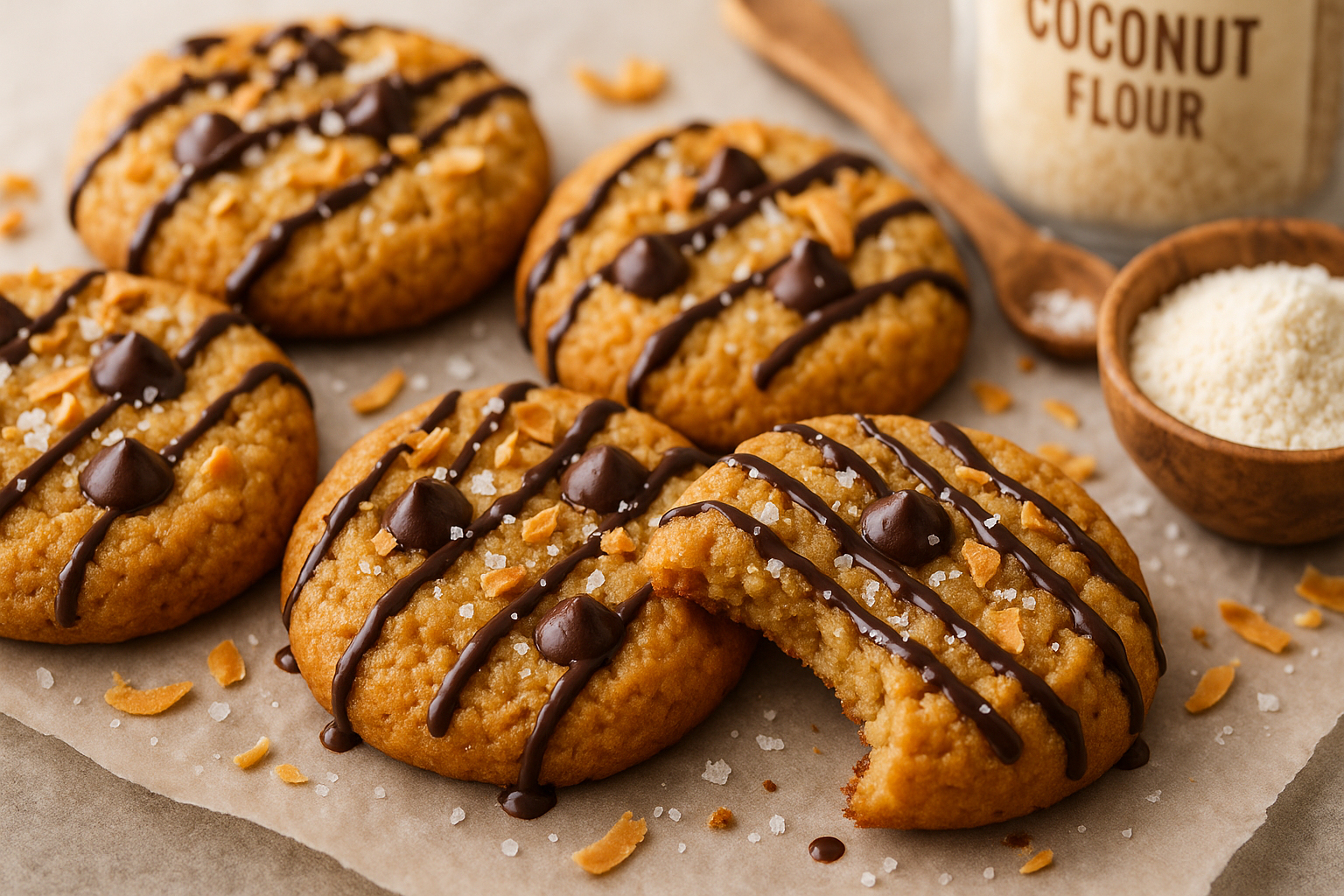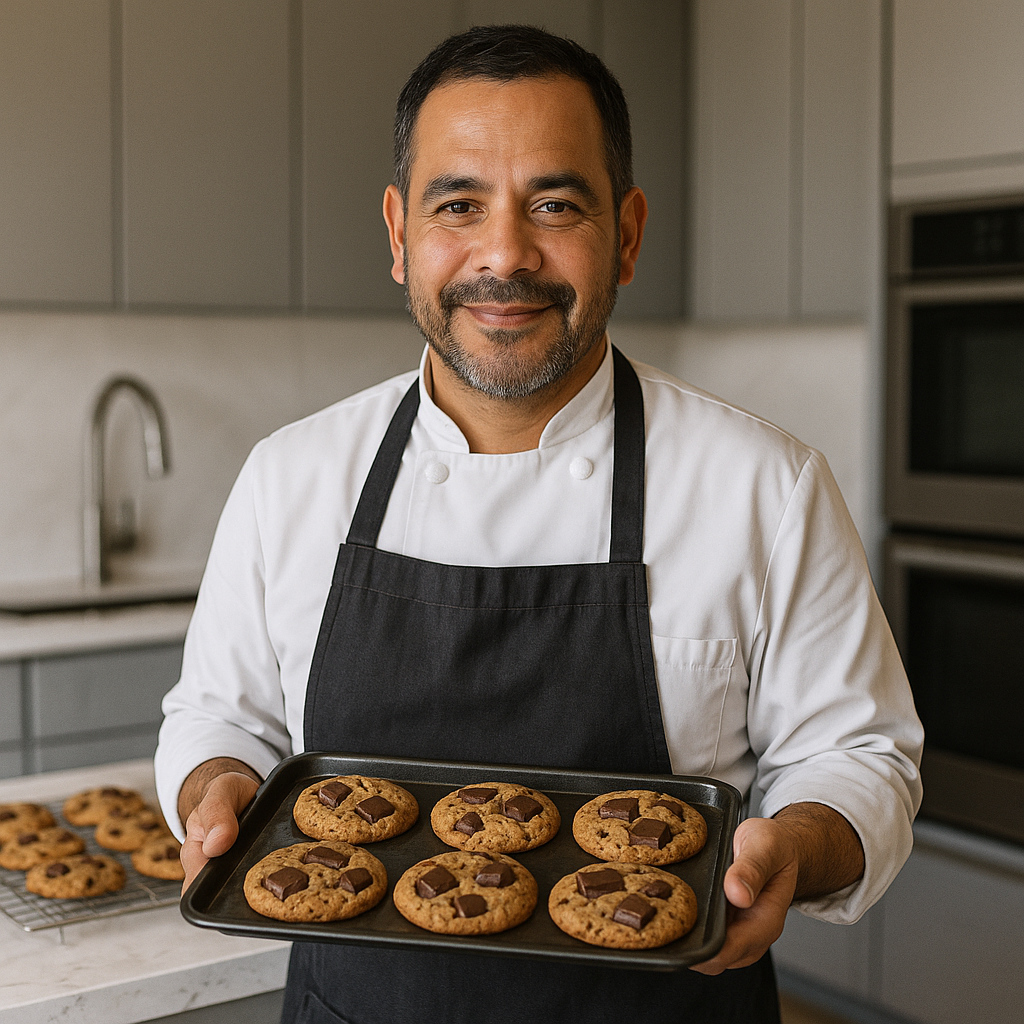Why moist egg structure matters in a coconut flour chocolate chip cookies recipe
Think of eggs as your precision framework. In a coconut flour chocolate chip cookies recipe, egg proteins set into a reliable network that supports crumb, while the yolks’ fat adds tenderness and moisture. Coconut flour is highly thirsty, so we need a steady, well‑balanced structure that holds water without turning cakey. That is why I use a moist egg structure: it gives lift, prevents crumbling, and keeps every bite soft at the center and crisp at the edge.
I keep this approach practical. We will combine exacting hydration with clear cues so you can hit the same texture every time. That mirrors how I test all cookies on this site, with straight‑to‑the‑point methods, gram weights, and visual checkpoints for consistent results . I also build each batch around a texture target, then back into the ratios and timing that make it repeatable at home .
Eggs also help carry chocolate flavor. Since we bake with Swiss chocolate here, I pay close attention to melt behavior and cocoa percentage. Those variables influence how the chips or chopped bars disperse and set inside the crumb, which I log in testing so our coconut flour chocolate chip cookies recipe stays balanced and not greasy . You will see that priority show up in the step‑by‑step below, where we add eggs in a way that maximizes stability and moisture.
Bottom line: without a moist egg structure, a coconut flour chocolate chip cookies recipe can dry out fast or crumble. With it, you get dependable spread, gentle chew, and a clean break. We will keep the method clear and repeatable, using the same test‑kitchen habits I rely on across all bakes, including recorded timings and practical notes you can trust at home .
Key benefits of the coconut flour swiss chocolate chip cookies recipe
This coconut flour swiss chocolate chip cookies recipe is designed for precision, reliability, and great flavor. First, you get a texture advantage: coconut flour can be fussy, but our moist egg structure and measured hydration keep the centers soft and edges crisp. Second, you get chocolate quality you can taste. Every recipe on this site centers Swiss chocolate, chosen for its smooth melt and consistent behavior, which helps your cookies bake evenly and taste balanced from the first batch .
You will also benefit from a clear testing philosophy. I document cocoa percentage, fat content, and format, then translate those findings into simple at‑home tweaks, so your first try feels confident and controlled . Because gram weights and step cues are provided, the coconut flour chocolate chip cookies recipe becomes repeatable, even if your oven or pans differ from mine .
Another advantage is fit for different dietary needs. While this recipe uses eggs for structure, the broader site includes gluten‑free standards and labeling guidance, which informs how I specify ingredients and flag potential cross‑contact. That means you get precise notes that help you bake within your comfort level . If you ever want to explore chocolate swaps, we also outline how to match cocoa percentage and format when you cannot find the Swiss bar I recommend, and we note when results may vary .
In short, you are getting a coconut flour chocolate chip cookies recipe calibrated for reliable texture, strong chocolate performance, and clear method support. You will see those benefits echoed in the ingredient list, tools, and step‑by‑step sections that follow.
Ingredients for the coconut flour swiss chocolate chip cookies recipe
Below is the exact ingredient framework I use to keep this coconut flour swiss chocolate chip cookies recipe dependable. I provide gram weights to support consistent results across kitchens, which is how I format all cookie recipes here .
- Swiss chocolate (chips, feves, or chopped bars), with cocoa percentage noted. I specify format and cocoa % so the melt and spread are predictable in your dough .
- Coconut flour, measured by weight for accuracy. Its absorbency demands precise hydration.
- Eggs, for moisture and structure. We will whisk to a uniform texture for balanced binding.
- Butter (or a suitable dairy‑free option when needed), chosen for consistent fat content in line with our ingredient standards .
- Granulated and light brown sugar, for spread, caramelization, and balanced chew.
- Vanilla extract for aroma, plus fine salt to sharpen flavor.
- Baking soda or a measured blend for lift and even browning.
When I write a coconut flour chocolate chip cookies recipe, I also include any gluten‑free notes you need to bake with confidence. The site’s gluten‑free guidance helps me flag blends, stabilizers, and label checks in a consistent way, so you always know what to look for at the store . If you must swap to a non‑Swiss chocolate, match cocoa percentage and shape to keep the crumb and spread close to target, noting that outcomes can vary .
These ingredients anchor the texture and flavor profile. Paired with a careful mixing method, they deliver a coconut flour chocolate chip cookies recipe that bakes up soft, flavorful, and stable.
Tools and equipment for the coconut flour swiss chocolate chip cookies recipe
Great cookies begin with straightforward tools. I keep the kit compact and purposeful, the same way I build every test run with clear steps and visual cues .
- Digital scale (where to find it) for gram‑accurate measuring. Precision is how we control spread and texture from batch to batch .
- Two baking sheets (where to find it) lined with parchment. Running two sheets lets you use different rack positions and maintain even browning .
- Medium and large mixing bowls (where to find it), plus a whisk and sturdy spatula for controlled mixing.
- Cookie scoop (where to find it) for uniform portioning, which helps match the timing cues I give.
- Cooling racks (where to find it) for setting structure quickly and preserving edges.
- Oven thermometer (where to find it) if your oven runs hot or cool, so our timing stays on target.
These tools map to the way I test cookies: I bake across rack positions and temperatures, log weights and timings, and share make‑ahead and freezer notes you can follow at home . That structure keeps the coconut flour chocolate chip cookies recipe consistent, whether you are baking a small trial batch or the full yield. Keep this setup handy and you will be able to adjust variables confidently while holding texture steady .
With this lineup in place, you will find the coconut flour swiss chocolate chip cookies recipe easier to follow and repeat.
Step-by-step dough mixing for the coconut flour swiss chocolate chip cookies recipe
We will mix with a calm, exact method. Short steps, clear cues, and weights keep your coconut flour swiss chocolate chip cookies recipe on track, just like every tested bake I share .
- Prep chocolate and dry mix. Log the chocolate’s cocoa percentage and format. Whisk coconut flour, baking soda, and salt until even. This baseline organization mirrors my test‑kitchen flow and pays off in reliable results .
- Cream butter and sugars. Mix until light but not airy. You want a steady base that can hold added moisture without collapsing.
- Build the moist egg structure. Whisk eggs separately until smooth, then stream into the creamed base. Mix just to combine. This is where a coconut flour chocolate chip cookies recipe gains stability without getting dense.
- Hydrate the coconut flour. Fold in the dry mix, then let the dough rest briefly so the flour hydrates. Controlled rest improves cohesion and prevents dry, crumbly cookies.
- Add Swiss chocolate. Stir in chocolate evenly. I pay attention to melt behavior so chips or chopped bars hold distinct pockets without pooling, a habit rooted in our practical testing notes .
- Portion and chill, if needed. Scoop uniformly. If dough feels soft, a short chill tightens structure so the coconut flour chocolate chip cookies recipe bakes with consistent spread.
These steps favor clarity and repeatability. By controlling hydration, egg structure, and chocolate format, you get a dough that bakes evenly, with the texture we set out to achieve .
Baking time and temperature guide for the coconut flour swiss chocolate chip cookies recipe
Time and temperature shape flavor, spread, and crinkle. I recommend running a small test bake first so you can confirm your oven’s behavior. This is the same controlled approach I use in my kitchen: I bake across rack positions and temperatures, and I record weights and timings so results stay consistent .
- Oven prep: Preheat fully and verify with an oven thermometer if possible.
- Rack positions: Start on the center rack for even heat, then test upper or lower racks if you want more color control. This mirrors my bake‑across‑racks habit for dialing in texture .
- Timing window: Pull when edges are set and centers show a soft dome. Let carryover heat finish the interior. Those visual cues are part of the step‑by‑step style I share on every recipe .
- Cooling: Rest on the sheet briefly, then move to a rack to secure structure and edge crispness.
If you adjust chocolate format, timing can shift. Feves and chopped bars can create molten pockets that hold heat longer, which is why I note format and cocoa % in every recipe card. Keeping those details precise helps the coconut flour chocolate chip cookies recipe perform reliably in your oven . If you need to match a different chocolate, follow our guidance to keep cocoa percentage and shape consistent so bake times remain predictable .
Use these cues and you will find the coconut flour swiss chocolate chip cookies recipe straightforward to bake, with a finish that is crisp at the edges and soft at the center.
Recipe Notes and FAQs list
Use these notes to lock in consistency and to adapt the coconut flour swiss chocolate chip cookies recipe to your kitchen. I provide make‑ahead and freezer notes across the site, plus visual timing cues and grams, so your bake stays dependable . Here are the essentials:
- Make‑ahead: Portion scoops, freeze on a sheet until firm, then bag. Bake from frozen with a short timing increase. I share make‑ahead and freezing instructions as part of my publishing standard .
- Chocolate swaps: If Swiss chocolate is unavailable, match cocoa percentage, fat content, and format. Expect minor differences, which I call out when relevant .
- Allergen and gluten‑free notes: Always check labels and consider cross‑contact. My gluten‑free standards specify blends and stabilizers clearly so you can follow your comfort level and guidance at home .
- Texture control: If cookies spread too little, reduce rest time or lighten the sugar ratio slightly. If dry, extend rest to hydrate or add a small moisture adjustment at mixing.
- Small‑batch: Halve the ingredients by weight for a quick test run. I encourage first‑bake trials, the same way I log small tests in the kitchen .
FAQs
- Can I bake without chilling? Often yes, if your dough feels stable. I give visual cues so you can decide in the moment .
- Can I use different chocolate shapes? Yes. Keep cocoa percentage and format notes in mind to maintain predictable melting and spread .
- What if I do not have a scale? I recommend grams for consistency, which is how I test and publish. If you must use volume, follow the visual and timing cues closely .
- How do I adapt for sensitivity to certain ingredients? Check labels carefully and follow your medical guidance. I include clear allergen notes to support safe choices at home .
Keep these notes nearby and you will get the most from the coconut flour chocolate chip cookies recipe. With measured hydration, a moist egg structure, and proven chocolate guidance, you will bake with steady, repeatable success.


